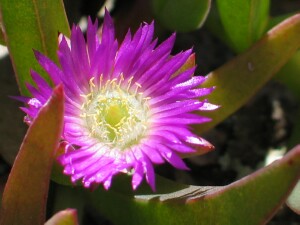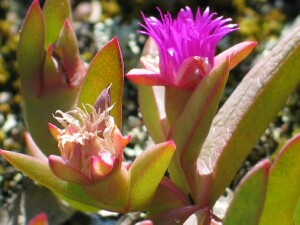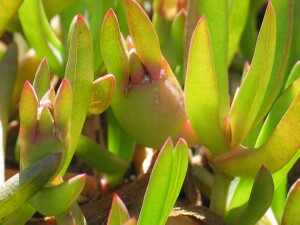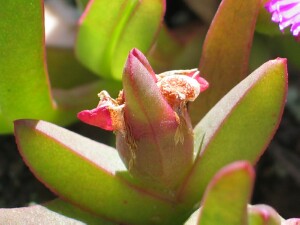Inland Pigface
Back | Salinity Indicator Plants Home | Common name home | Scientific name home | Photo Gallery | Glossary
| Inland Pigface photos |
| Scientific Name: | Carpobrotus modestus |  Inland Pigface plant Photo: A J Brown | |||||
| Status | Native to Australia. | ||||||
Plant Description: | Perennial succulent with trailing stems to 50 cm long, which often root at the nodes. Leaves opposite, generally 3-7 cm long and 4-9 mm thick (often thicker than wide), glaucous (blue-green with a whitish bloom) but sometimes tinged pink, smooth and triangular with more or less flat (slightly concave) faces and sharp angles. Flowers are about 2 cm diameter when open and of numerous linear light purple petals which merge to white at their bases. The fruit is fig-like, fleshy and indehiscent, slightly compressed and oblong to ellipsoid in shape, 1.5-2 cm long and purplish in colour. Flowers in spring and summer. | ||||||
Habitat: | Not uncommon on shallow, rocky or deep sandy soils in Mallee communities of Victoria, South Australia and Western Australia. Also found in western and central districts of Victoria.
| ||||||
Comments: | Both the fruit and leaves were used as a food source by indigenous Australians. Similar to other Pigfaces (see Key to Pigfaces and similar plants). May be confused with Rounded Noon-flower (Disphyma crassifolium subsp. clavellatum) which can grow in the same habitats, but the leaves of the Noon-flower have rounded angles. A long-leaved Pigface from far north-west Victoria is thought to be either a new undescribed species, a polyploid race of Inland Pigface (Carpobrotus modestus) or a hybrid between other Pigface species. It is most similar to Karkalla and is currently known as Carpobrotus aff. rossii. |
 Flower of Inland Pigface Photo: A J Brown |  Inland Pigface flowers Photo: A J Brown |
|
|




